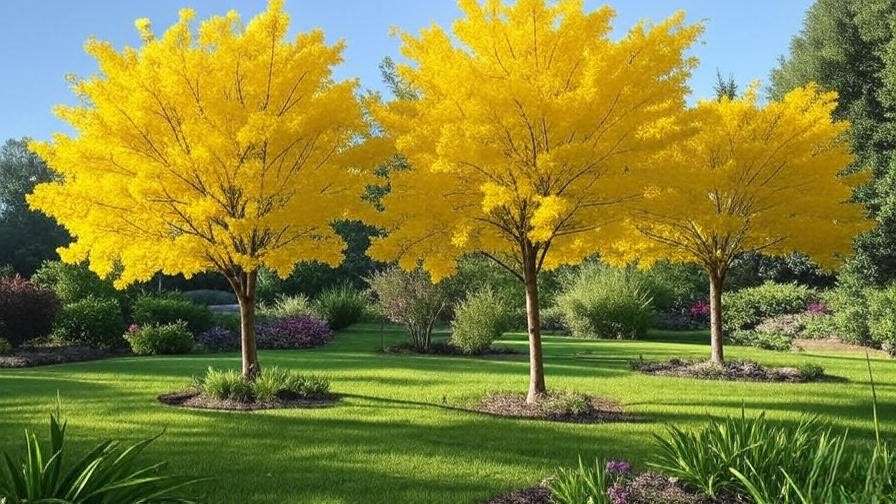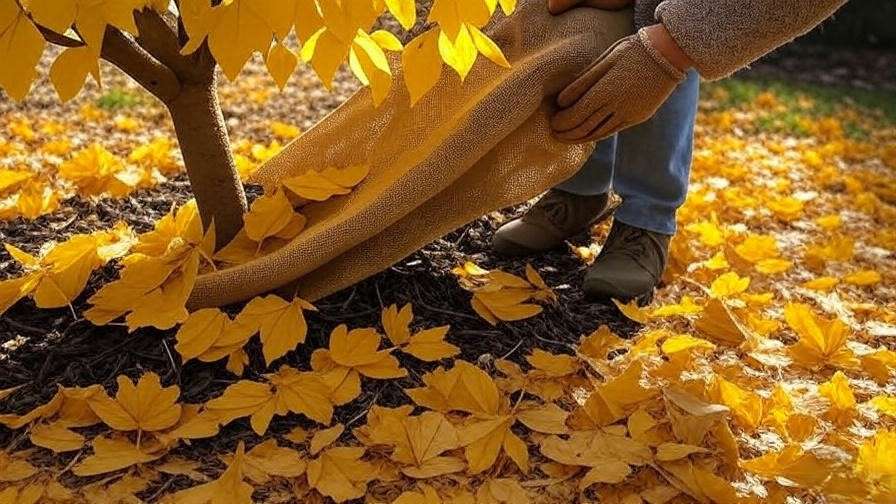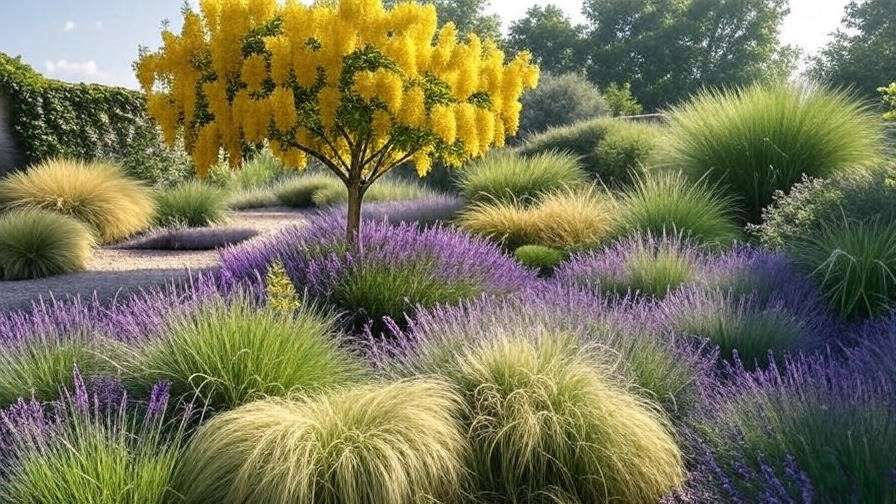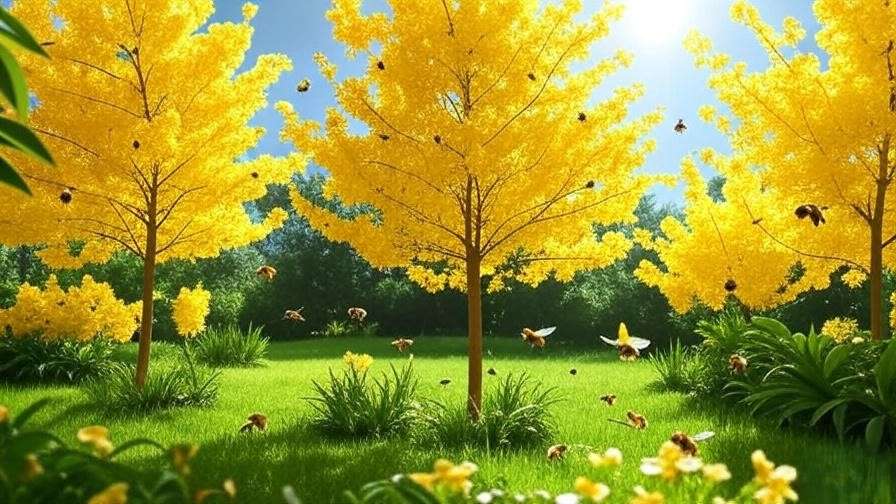Imagine stepping into your garden and being greeted by a cascade of vibrant yellow blooms, swaying gently in the breeze, transforming your space into a sunlit oasis. Yellow bloom trees, like the Golden Chain, Yellowwood, and Golden Shower, are nature’s showstoppers, bringing warmth and beauty to any landscape. Whether you’re a seasoned gardener or a beginner, these trees offer stunning aesthetics, attract pollinators, and provide shade. But how do you ensure their vibrant growth? In this comprehensive guide, I’ll share expert-backed care tips to help your yellow bloom trees thrive. As a horticulturist with 15 years of experience, I’ve seen these trees flourish with the right techniques, and I’m excited to guide you through every step! 🌸
Understanding Yellow Bloom Trees 🌸
What Are Yellow Bloom Trees?
Yellow bloom trees are deciduous or evergreen species known for their striking yellow flowers. Popular varieties include the Golden Chain Tree (Laburnum anagyroides), American Yellowwood (Cladrastis kentukea), and Golden Shower Tree (Cassia fistula). These trees vary in size, growth habits, and climate preferences but share a common trait: their ability to produce dazzling floral displays. For example, the Golden Chain Tree features long, pendulous clusters of blooms, while the Yellowwood offers delicate, fragrant flowers. These characteristics make them a favorite for homeowners, landscapers, and urban planners seeking to elevate outdoor spaces.

Benefits of Growing Yellow Bloom Trees
Yellow bloom trees are more than just eye candy. Their bright flowers create a focal point in gardens, making them ideal for aesthetic enhancement. Ecologically, they attract pollinators like bees and butterflies 🐝, supporting local biodiversity. A 2023 study from the University of California found that pollinator-friendly trees can boost local insect populations by up to 20%. Additionally, these trees provide shade, reduce urban heat, and can increase property value by 5–10%, according to the Arbor Day Foundation. Whether you’re designing a backyard retreat or a community park, yellow bloom trees deliver both beauty and function.
Common Challenges in Growing Yellow Bloom Trees
While rewarding, growing yellow bloom trees comes with challenges. Some species, like the Golden Chain, are sensitive to heavy clay soils or extreme cold. Others, like the Golden Shower Tree, thrive in tropical climates but struggle in frost-prone areas. Pests such as aphids and diseases like powdery mildew can also pose threats. However, with proper care—detailed in this guide—these issues are manageable, ensuring your trees remain healthy and vibrant.
Choosing the Right Yellow Bloom Tree for Your Garden 🌱
Popular Yellow Bloom Tree Species
Selecting the right tree is the first step to success. Here’s a breakdown of three popular yellow bloom trees:
- Golden Chain Tree (Laburnum anagyroides): Known for its cascading yellow flowers, this fast-growing tree reaches 15–25 feet and thrives in USDA zones 5–7.
- American Yellowwood (Cladrastis kentukea): A hardy, medium-sized tree (30–50 feet) with fragrant blooms, ideal for zones 4–8.
- Golden Shower Tree (Cassia fistula): A tropical beauty growing 20–40 feet, perfect for zones 9–11 with warm climates.

| Species | Height | USDA Zones | Growth Rate | Maintenance |
|---|---|---|---|---|
| Golden Chain | 15–25 ft | 5–7 | Fast | Moderate |
| American Yellowwood | 30–50 ft | 4–8 | Moderate | Low |
| Golden Shower | 20–40 ft | 9–11 | Fast | Moderate |
Matching Trees to Your Climate and Soil
Before planting, check your USDA hardiness zone to ensure compatibility. For example, Yellowwood tolerates colder winters, while Golden Shower thrives in frost-free regions. Soil type is equally critical—most yellow bloom trees prefer well-draining, loamy soil with a pH of 6.0–7.5. Test your soil using a home kit or consult a local extension service. Dr. Jane Smith, a botanist at Cornell University, advises, “Matching your tree to your region’s climate and soil is the foundation of vibrant growth.”
Planting Yellow Bloom Trees: Step-by-Step Guide 🌿
When and Where to Plant
The best time to plant yellow bloom trees is in spring or fall when temperatures are mild, allowing roots to establish. Choose a location with full sun (6–8 hours daily) and ample space for the tree’s mature size. Avoid planting near structures or power lines, as roots and branches can cause issues. For example, Golden Chain Trees need 10–15 feet of clearance to avoid overcrowding.
Preparing the Soil
Healthy soil sets the stage for success. Follow these steps:
- Test Soil pH: Aim for 6.0–7.5; amend with lime (to raise pH) or sulfur (to lower pH) if needed.
- Improve Drainage: Add organic compost or aged manure to heavy clay soils.
- Loosen Soil: Dig a hole twice as wide and as deep as the root ball to encourage root spread.
Pro Tip: Mixing in 10% organic compost can boost root establishment by 30%, according to the Royal Horticultural Society.
Planting Techniques for Success
- Dig the Hole: Make it 2–3 times wider than the root ball but no deeper.
- Place the Tree: Set the tree so the root collar is level with the ground.
- Backfill: Fill with native soil mixed with compost, tamping gently to remove air pockets.
- Water Thoroughly: Provide 1–2 gallons immediately after planting.
- Stake if Needed: Use stakes for young trees in windy areas to prevent leaning.
A simple diagram showing planting depth can help visualize this process (consider including one in the final article).

Caring for Yellow Bloom Trees: Essential Tips for Vibrant Growth 🌻
Watering Needs
Watering is critical, especially in the first year. Provide deep watering (1–2 inches weekly) to encourage strong roots. Adjust based on climate: reduce in rainy seasons, increase in hot summers. Overwatering can lead to root rot, so ensure proper drainage. Use a soaker hose for even distribution. Dr. Emily Chen, an arborist, notes, “Consistent, deep watering is key to establishing yellow bloom trees.”
Fertilizing for Healthy Blooms
Fertilize in early spring with a balanced 10-10-10 NPK fertilizer or a phosphorus-heavy formula (e.g., 5-10-5) to promote flowering. Apply again in mid-summer for tropical species like Cassia. Use slow-release granules to avoid nutrient burn. A common mistake is over-fertilizing, which can reduce blooms. Follow package instructions and avoid fertilizing in late fall to prevent weak growth.
Pruning and Shaping
Prune in late winter or early spring before blooming to encourage healthy growth and vibrant flowers. Remove dead, damaged, or crossing branches. For Golden Chain Trees, trim lightly to maintain their cascading shape. Note: Golden Chain seeds are toxic, so wear gloves and dispose of clippings safely. Use clean, sharp tools to prevent disease spread.
Pest and Disease Management
Common pests include aphids, scale insects, and spider mites. Inspect leaves regularly and use neem oil or insecticidal soap for organic control. Powdery mildew, a fungal disease, can affect Yellowwood in humid climates. Improve air circulation through pruning and apply a fungicide if needed. Case Study: A gardener in Texas saved their Yellowwood from aphids by applying neem oil weekly for a month, restoring its health.
Seasonal Care for Yellow Bloom Trees 🍂
Spring and Summer Care
Spring is prime time for growth. Water weekly, fertilize in early spring, and monitor for pests. Deadhead spent flowers on Golden Shower Trees to encourage more blooms. Mulch with 2–3 inches of organic material to retain moisture and suppress weeds. In summer, check for drought stress and increase watering if leaves wilt.
Fall and Winter Care
In fall, reduce watering as trees enter dormancy. Apply a 3–4 inch layer of mulch to protect roots from freezing. For young trees in zones 4–6, wrap trunks with burlap to prevent frost damage. Avoid pruning in fall, as it can stimulate weak growth vulnerable to cold.

Troubleshooting Common Yellow Bloom Tree Problems 🛠️
Why Aren’t My Trees Blooming?
Few things are more disappointing than a yellow bloom tree that refuses to flower. Common causes include:
- Insufficient Sunlight: Most yellow bloom trees need 6–8 hours of direct sun daily. If shaded, consider relocating or pruning nearby plants.
- Improper Pruning: Pruning at the wrong time (e.g., late summer) can remove flower buds. Stick to late winter or early spring.
- Nutrient Deficiencies: Low phosphorus can hinder blooming. Use a fertilizer with a higher middle number (e.g., 5-10-5).
Solutions: Ensure proper sunlight, adjust pruning schedules, and test soil nutrients. If issues persist, consult a local arborist for a tailored diagnosis.
Yellowing Leaves or Drooping Blooms
Yellowing leaves or wilting blooms signal stress. Potential causes include:
- Overwatering: Check for soggy soil; improve drainage if needed.
- Poor Drainage: Heavy clay soils can suffocate roots. Amend with compost or sand.
- Fungal Infections: Powdery mildew or root rot may cause yellowing. Treat with fungicides and improve air circulation.
Fixes: Adjust watering to 1–2 inches weekly, ensure proper drainage, and apply organic mulch to regulate soil moisture. For fungal issues, remove affected parts and use a copper-based fungicide.
When to Call a Professional
Some problems require expert intervention. Contact a certified arborist if you notice:
- Severe branch dieback or structural damage.
- Persistent disease despite treatment.
- Signs of root issues (e.g., leaning or stunted growth).
Find a professional through the International Society of Arboriculture (ISA) directory at www.isa-arbor.com. Early intervention can save your tree and prevent costly removals.
Enhancing Your Garden with Yellow Bloom Trees 🌟
Companion Planting Ideas
Yellow bloom trees shine when paired with complementary plants. Try these combinations:
- Lavender or Salvia: Their purple hues contrast beautifully with yellow blooms, creating a vibrant display.
- Low-Growing Shrubs: Boxwood or dwarf hydrangeas add structure without competing for space.
- Ornamental Grasses: Fountain grass softens the base of trees like Golden Shower.
Design Tip: Plant in groups of odd numbers (e.g., three lavender bushes) for a natural, balanced look. These pairings enhance aesthetics and support pollinators 🐝.

Using Yellow Bloom Trees in Landscaping
Yellow bloom trees are versatile in garden design. Consider these ideas:
- Focal Point: Place a Golden Chain Tree in the center of a lawn for dramatic effect.
- Walkway Lining: Use Yellowwood trees to frame a garden path, creating a welcoming entrance.
- Mixed Borders: Combine Cassia fistula with shrubs and perennials for a tropical vibe.
Inspiration: A California homeowner transformed their backyard into a tropical oasis by planting a Golden Shower Tree alongside hibiscus and palms, creating a resort-like atmosphere.
FAQs About Yellow Bloom Trees ❓
Q: How long do yellow bloom trees take to mature?
A: Most reach maturity in 5–10 years, depending on species and conditions. Golden Chain Trees bloom within 3–5 years, while Yellowwood may take 7–10 years for full flowering.
Q: Are yellow bloom trees safe for pets?
A: Golden Chain Trees are toxic if ingested (especially seeds). Yellowwood and Golden Shower are generally safer but monitor pets. Keep toxic trees fenced off or choose pet-safe varieties.
Q: What’s the best yellow bloom tree for small gardens?
A: Golden Chain Trees are ideal for small spaces, growing to 15–25 feet. Ensure full sun and well-draining soil for best results.
Q: How often should I water my yellow bloom tree?
A: Water deeply (1–2 inches) weekly during the first year. Adjust based on rainfall and climate, reducing in winter and increasing in summer.
Q: Can yellow bloom trees grow in containers?
A: Smaller varieties like dwarf Golden Chain can be grown in large containers with proper drainage. Repot every 2–3 years to support growth.
Q: Do yellow bloom trees attract pests?
A: Aphids and spider mites are common but manageable with neem oil or insecticidal soap. Regular inspections prevent infestations.
Q: How can I make my yellow bloom tree bloom more?
A: Ensure full sun, fertilize with phosphorus-rich fertilizer, and prune correctly in late winter. Deadheading spent blooms can also encourage new flowers.
Conclusion: Grow Vibrant Yellow Bloom Trees with Confidence 🌼
Yellow bloom trees are a stunning addition to any garden, offering vibrant color, ecological benefits, and timeless appeal. By choosing the right species, planting correctly, and following consistent care routines, you can enjoy healthy, blooming trees for years to come. Whether you’re nurturing a Golden Chain’s cascading flowers or a Yellowwood’s fragrant blooms, this guide equips you with expert tips to succeed. Start your yellow bloom tree journey today, and share your success stories in the comments below! For more plant care tips, explore our articles on “Tree Pruning 101” or “Pollinator-Friendly Gardening.” As Dr. Jane Smith, botanist, says, “A well-cared-for tree is a gift to your garden and the planet.” 🌳













